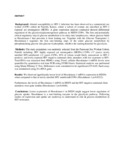| dc.contributor.author | Apidi, Winnie | |
| dc.contributor.author | Chi, Su Ruey | |
| dc.contributor.author | Kimani, Joshua | |
| dc.contributor.author | Frank, Plummer | |
| dc.contributor.author | Ball, Blake | |
| dc.date.accessioned | 2015-04-02T12:36:17Z | |
| dc.date.available | 2015-04-02T12:36:17Z | |
| dc.date.issued | 2014 | |
| dc.identifier.citation | Apidi Winnie, Su Ruey Chi, Kimani Joshua, Plummer Frank, and Ball Blake. AIDS Research and Human Retroviruses. October 2014, 30(S1): A218-A218 | en_US |
| dc.identifier.uri | http://online.liebertpub.com/doi/full/10.1089/aid.2014.5474.abstract | |
| dc.identifier.uri | http://hdl.handle.net/11295/81894 | |
| dc.description.abstract | Background: Altered susceptibility to HIV-1 infection has been observed in a commercial sex worker (CSW) cohort in Nairobi, Kenya, where a subset of women are classified as HIV-1 exposed yet seronegative (HESN). A gene expression analysis conducted showed differential regulation of the glycolysis/gluconeogenesis pathway in HESN CSWs. The first and potentially critical regulatory step in glucose metabolism is its entry into lymphocytes, where glucose binds to Hexokinase-1 that prevents it from leaking out. Together with the Glucose Transporter 1, Hexokinase-1 regulates the first rate-limiting steps of the entire glucose metabolism by phosphorylating glucose into glucose-6-phosphate, which is the starting material for glycolysis.
Methods: The study population was randomly selected from the Pumwani Sex Worker Cohort, Nairobi including: HIV highly exposed yet seronegative (HESNs) CSWs (>7 years); newly enrolled HIV-uninfected (<3 years) CSWs, 85% of whom would likely seroconvert to HIV-1 positive; and lowly-exposed HIV negative antenatal clinic attendees with low exposure to HIV. Total RNA was extracted from PBMCs using Trizol; cellular Hexokinase-1 mRNA levels were quantified by quantitative real time PCR using SYBR Green. Statistical analysis was performed using Mann-Whitney U Test. Differences were considered to be significant if P<0.05. Each assay was normalized using 18s rRNA gene.
Results: We observed significantly lower level of Hexokinase-1 mRNA expression in HESNs when compared to that in newly enrolled HIV uninfected CSWs (Hexokinase-1 p=0.0323).
Furthermore, the levels of Hexokinase-1 mRNA in HESN and the HIV negative antenatal clinic attendees were quite similar (Hexokinase-1 p=0.6448).
Conclusions: Lower expression of Hexokinase-1 in HESN might suggest lower regulation of glucose uptake. Hexokinase is a rate-limiting enzyme in the glycolysis pathway. Following studies of expression and uptake are underway to understand its role in glucose metabolism in HIV resistance. | en_US |
| dc.language.iso | en | en_US |
| dc.publisher | University of Nairobi | en_US |
| dc.title | The Expression Analysis of Hexokinase 1 Gene in the Pumwani Commercial Sex Worker Cohort, Nairobi, Kenya | en_US |
| dc.type | Article | en_US |
| dc.type.material | en | en_US |

